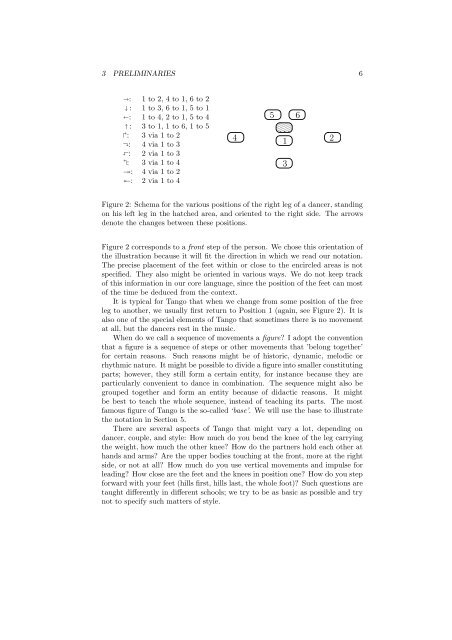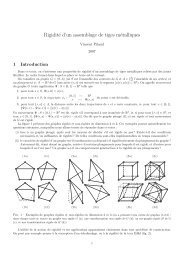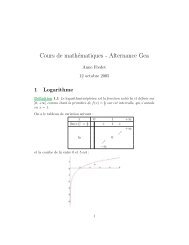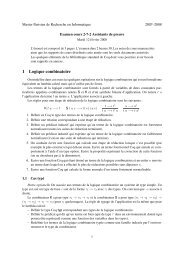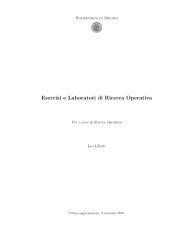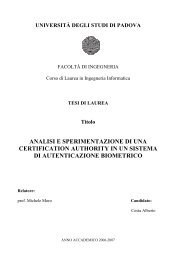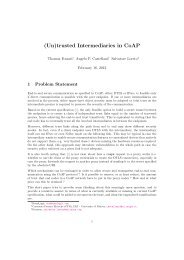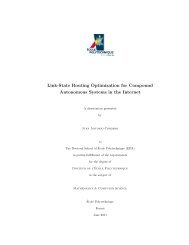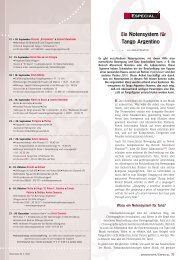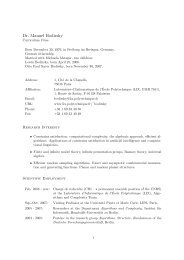You also want an ePaper? Increase the reach of your titles
YUMPU automatically turns print PDFs into web optimized ePapers that Google loves.
3 PRELIMINARIES 6<br />
: 1 to 2, 4 to 1, 6 to 2<br />
: 1 to 3, 6 to 1, 5 to 1<br />
: 1 to 4, 2 to 1, 5 to 4<br />
: 3 to 1, 1 to 6, 1 to 5<br />
: 3 via 1 to 2<br />
: 4 via 1 to 3<br />
<br />
<br />
: 2 via 1 to 3<br />
: 3 via 1 to 4<br />
։: 4 via 1 to 2<br />
և: 2 via 1 to 4<br />
5 6<br />
00 11<br />
00 11<br />
00 11<br />
00 11<br />
4 1 2<br />
Figure 2: Schema <strong>for</strong> the various positions of the right leg of a dancer, standing<br />
on his left leg in the hatched area, and oriented to the right side. The arrows<br />
denote the changes between these positions.<br />
Figure 2 corresponds to a front step of the person. We chose this orientation of<br />
the illustration because it will fit the direction in which we read our notation.<br />
The precise placement of the feet within or close to the encircled areas is not<br />
specified. They also might be oriented in various ways. We do not keep track<br />
of this in<strong>for</strong>mation in our core language, since the position of the feet can most<br />
of the time be deduced from the context.<br />
It is typical <strong>for</strong> <strong>Tango</strong> that when we change from some position of the free<br />
leg to another, we usually first return to Position 1 (again, see Figure 2). It is<br />
also one of the special elements of <strong>Tango</strong> that sometimes there is no movement<br />
at all, but the dancers rest in the music.<br />
When do we call a sequence of movements a figure? I adopt the convention<br />
that a figure is a sequence of steps or other movements that ’belong together’<br />
<strong>for</strong> certain reasons. Such reasons might be of historic, dynamic, melodic or<br />
rhythmic nature. It might be possible to divide a figure into smaller constituting<br />
parts; however, they still <strong>for</strong>m a certain entity, <strong>for</strong> instance because they are<br />
particularly convenient to dance in combination. The sequence might also be<br />
grouped together and <strong>for</strong>m an entity because of didactic reasons. It might<br />
be best to teach the whole sequence, instead of teaching its parts. The most<br />
famous figure of <strong>Tango</strong> is the so-called ‘base’. We will use the base to illustrate<br />
the notation in Section 5.<br />
There are several aspects of <strong>Tango</strong> that might vary a lot, depending on<br />
dancer, couple, and style: How much do you bend the knee of the leg carrying<br />
the weight, how much the other knee? How do the partners hold each other at<br />
hands and arms? Are the upper bodies touching at the front, more at the right<br />
side, or not at all? How much do you use vertical movements and impulse <strong>for</strong><br />
leading? How close are the feet and the knees in position one? How do you step<br />
<strong>for</strong>ward with your feet (hills first, hills last, the whole foot)? Such questions are<br />
taught differently in different schools; we try to be as basic as possible and try<br />
not to specify such matters of style.<br />
3


